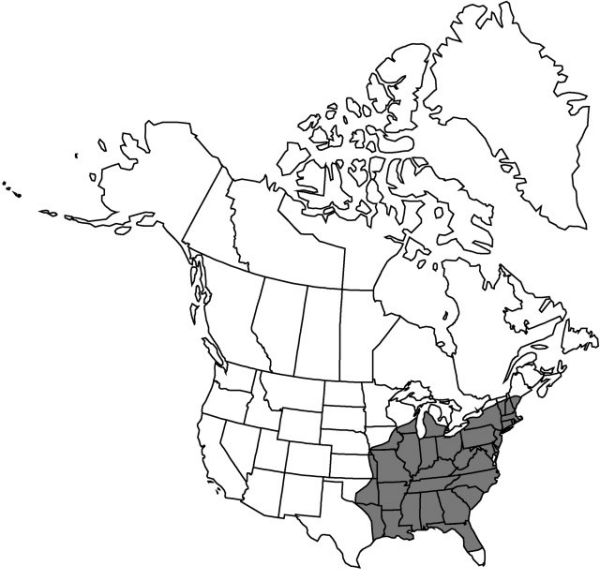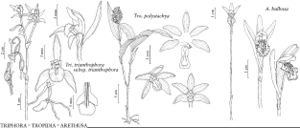Triphora trianthophoros subsp. trianthophoros
Plants 7–20(–30) cm. Roots from spheroid to ovoid or nearly cylindric tuberoids, 10–30 × 5–15 mm. Stems purple or sometimes green apically, unbranched or rarely branched from base. Leaves 2–6; blade abaxially green or suffused or veined with purple, adaxially green, not bractlike, broadly ovate, margins entire. Inflorescences (1–)3–6(–20)-flowered racemes. Flowers resupinate, nodding to nearly erect, gaping, white, often tinged with pale pink or fading to pale pink with age; flowering synchronous and ephemeral, occasionally flowers may persist for 2–4 days; dorsal sepal oblanceolate, 11–15 × 3–4 mm; lateral sepals oblanceolate, falcate, 11–15 × 3–4 mm; petals oblanceolate, falcate, 11–14 × 3–4 mm; lip facing away from stem, white, obovate, clawed, 3-lobed, 8–20 × 6–10 mm, middle lobe ovate to nearly circular, lateral lobes ovate to ovate-triangular, margins sinuate-denticulate; disc with 3 bright green, papillose crests; column white, clavate, slender, 10 × 2 mm; pollinia magenta. Capsules pendent or erect, ellipsoid, 10–15 × 5–10 mm. 2n = 44.
Phenology: Flowering summer–late fall.
Habitat: Dry-mesic to mesophytic forests over sandstone or limestone, sandy oak-mixed hardwood forests, seasonally wet, sandy flatwoods, Great Lakes dune forests, coniferous forests, tamarack swamps, rhododendron thickets, floodplain forests, wet muck in glacial lake bed forest, and in seasonally flooded sinkhole swamps
Elevation: 0–2000 m
Distribution

Ont., Ala., Ark., Conn., Del., D.C., Fla., Ga., Ill., Ind., Iowa, Kans., Ky., La., Maine, Md., Mass., Mich., Miss., Mo., Nebr., N.H., N.J., N.Y., N.C., Ohio, Okla., Pa., S.C., Tenn., Tex., Vt., Va., W.Va., Wis., nc Mexico.
Discussion
Pollination is by small (mostly halictid) bees (M. E. Medley 1979). Pollination by small bees, mostly Augochlora pura, has also been reported (P. M. Catling and V. R. Catling 1991). Flowers of Triphora trianthophora subsp. trianthophora usually last only one day, sometimes 2–4 days near its western limit.
Triphora trianthophora subsp. mexicana (S. Watson) Medley occurs in Mexico and in Central America (El Salvador, Guatemala, Honduras, Panama).
Selected References
None.
